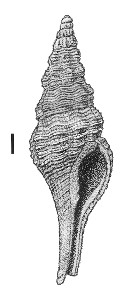
Revised descriptions of New Zealand Cenozoic Mollusca from Beu and Maxwell (1990)

 | Revised descriptions of New Zealand Cenozoic Mollusca from Beu and Maxwell (1990) | 
|
  (Pl. 21l): GS11154, J39/f26, foot of Mt Horrible, Pareora River, South Canterbury, Otaian (GNS) |
Beu & Maxwell (1990): Chapter 11; p. 202; pl. 21 l.
Synonymy: Pleia otaioensis Finlay 1930b, p. 60.; Beu & Maxwell 1990, p. 202, pl. 21l
Classification: Turbinellidae
Description: Size moderate for family (height 30-38 mm), fusiform, spire about half total height. Protoconch mamillate, apparently of about 1.5 smooth whorls, but incompletely known. Teleoconch of 6-7 whorls, narrowly concave adapically, strongly convex below, last whorl broadly excavated, base convex, neck long and narrow. Axial sculpture of prominent, broad, rounded costae with concave interspaces, reaching from lower edge of subsutural concave zone to lower suture on spire, and extending onto base of last whorl; 7-9 costae on penultimate whorl. Spiral sculpture of prominent, low, narrow cords, 7 or 8 (some with interstitial threads) on penultimate whorl, 2 or 3 on ramp somewhat weaker than those below. Numerous additional cords appearing on base and neck, those on neck crowded and rather indistinct. Spirals crossing costae with little or no change. Aperture pyriform, constricted adapically by prominent parietal tubercle; columella almost straight, only weakly twisted, with a plait of variable strength on or slightly above twist, some shells with a second plait above. Inner lip moderately callused, outer lip thin, weakly flexuous, edge finely crenulate, some shells with 7-9 narrow lirae within. Siphonal canal long, narrow, almost straight.
Comparison: Otaiofusus cryptocarinatus (Mangapanian-Recent), the type species of Otaiofusus Beu, 2009, has a less slender shell and more strongly convex teleoconch whorls, and lacks the strong parietal tubercle of O. otaioensis. Neither O. otaioensis nor O. cryptocarinatus is very closely related to the type species of Pleia Finlay, 1930 (Fasciolaria decipiens Tate, 1888, = tenisoni Tenison Woods, 1879; Balcombian, Middle Miocene, Muddy Creek, Victoria, and River Murray cliffs, South Australia), which is much larger than either of the New Zealand species (height 70 mm, compared with 20-35 mm for Otaiofusus species), has distinctly shouldered teleoconch whorls, and has a long, narrow, straight siphonal canal, with a single low, indistinct columellar plait, and so resembles Latirus, Pleuroploca and Hemipolygona much more than the New Zealand species Finlay referred to Pleia. Vermeij & Snyder (2006, p. 414) referred Latirus and similar genera to the Fasciolariidae, but placed Dolicholatirus and similar tall, narrow genera in the Turbinellidae, and on that basis the similar but shorter genus Otaiofusus is referred to the Turbinellidae. Otaiofusus otaioensis probably had a similar habitat to O. cryptocarinatus, i.e. on level bottoms in the upper bathyal zone.
Distribution: Waitakian?, Otaian; Mount Harris Formation, Bluecliffs, Otaio River, Otaian (type); Mt Horrible, Pareora River; "The Peaks", Waihao Valley; ?upper Tengawai River (rare to uncommon).
Cite this publication as: "A.G. Beu and J.I. Raine (2009). Revised
descriptions of New Zealand Cenozoic Mollusca from Beu and Maxwell (1990). GNS
Science miscellaneous series no. 27."
© GNS Science, 2009
ISBN
978-0-478-19705-1
ISSN 1177-2441
(Included with a PDF facsimile file
copy of New Zealand Geological Survey Paleontological Bulletin 58 in CD version
from: Publications Officer, GNS Science, P.O. Box 30368 Lower Hutt, New
Zealand)